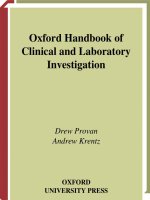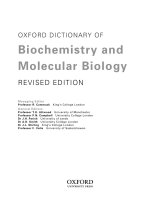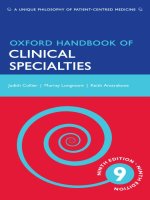- Trang chủ >>
- Y - Dược >>
- Ngoại khoa
oxford handook of endocrinology and diabetes 3rd ed
Bạn đang xem bản rút gọn của tài liệu. Xem và tải ngay bản đầy đủ của tài liệu tại đây (3.24 MB, 934 trang )
OXFORD MEDICAL PUBLICATIONS
Oxford Handbook of
Endocrinology and
Diabetes
Published and forthcoming Oxford Handbooks
Oxford Handbook for the Foundation Programme 3e
Oxford Handbook of Acute Medicine 3e
Oxford Handbook of Anaesthesia 3e
Oxford Handbook of Applied Dental Sciences
Oxford Handbook of Cardiology 2e
Oxford Handbook of Clinical and Laboratory Investigation 3e
Oxford Handbook of Clinical Dentistry 5e
Oxford Handbook of Clinical Diagnosis 2e
Oxford Handbook of Clinical Examination and Practical Skills
Oxford Handbook of Clinical Haematology 3e
Oxford Handbook of Clinical Immunology and Allergy 3e
Oxford Handbook of Clinical Medicine – Mini Edition 8e
Oxford Handbook of Clinical Medicine 9e
Oxford Handbook of Clinical Pathology
Oxford Handbook of Clinical Pharmacy 2e
Oxford Handbook of Clinical Rehabilitation 2e
Oxford Handbook of Clinical Specialties 9e
Oxford Handbook of Clinical Surgery 4e
Oxford Handbook of Complementary Medicine
Oxford Handbook of Critical Care 3e
Oxford Handbook of Dental Patient Care
Oxford Handbook of Dialysis 3e
Oxford Handbook of Emergency Medicine 4e
Oxford Handbook of Endocrinology and Diabetes 3e
Oxford Handbook of ENT and Head and Neck Surgery 2e
Oxford Handbook of Epidemiology for Clinicians
Oxford Handbook of Expedition and Wilderness Medicine
Oxford Handbook of Forensic Medicine
Oxford Handbook of Gastroenterology & Hepatology 2e
Oxford Handbook of General Practice 4e
Oxford Handbook of Genetics
Oxford Handbook of Genitourinary Medicine, HIV and AIDS 2e
Oxford Handbook of Geriatric Medicine 2e
Oxford Handbook of Infectious Diseases and Microbiology
Oxford Handbook of Key Clinical Evidence
Oxford Handbook of Medical Dermatology
Oxford Handbook of Medical Imaging
Oxford Handbook of Medical Sciences 2e
Oxford Handbook of Medical Statistics
Oxford Handbook of Neonatology
Oxford Handbook of Nephrology and Hypertension 2e
Oxford Handbook of Neurology 2e
Oxford Handbook of Nutrition and Dietetics 2e
Oxford Handbook of Obstetrics and Gynaecology 3e
Oxford Handbook of Occupational Health 2e
Oxford Handbook of Oncology 3e
Oxford Handbook of Ophthalmology 2e
Oxford Handbook of Oral and Maxillofacial Surgery
Oxford Handbook of Orthopaedics and Trauma
Oxford Handbook of Paediatrics 2e
Oxford Handbook of Pain Management
Oxford Handbook of Palliative Care 2e
Oxford Handbook of Practical Drug Therapy 2e
Oxford Handbook of Pre-Hospital Care
Oxford Handbook of Psychiatry 3e
Oxford Handbook of Public Health Practice 3e
Oxford Handbook of Reproductive Medicine & Family Planning 2e
Oxford Handbook of Respiratory Medicine 2e
Oxford Handbook of Rheumatology 3e
Oxford Handbook of Sport and Exercise Medicine 2e
Handbook of Surgical Consent
Oxford Handbook of Tropical Medicine 4e
Oxford Handbook of Urology 3e
Oxford Handbook of
Endocrinology
and Diabetes
Third edition
Edited by
John Wass
Professor of Endocrinology,
Oxford Centre for Diabetes,
Endocrinology and Metabolism (OCDEM),
Oxford, UK
Katharine Owen
Senior Clinical Researcher and Honorary Consultant,
Oxford Centre for Diabetes, Endocrinology and
Metabolism (OCDEM), Oxford, UK
Advisory editor
Helen Turner
Consultant in Endocrinology
Oxford Centre for Diabetes, Endocrinology and
Metabolism (OCDEM), Oxford, UK
1
3
Great Clarendon Street, Oxford, OX2 6DP,
United Kingdom
Oxford University Press is a department of the University of Oxford.
It furthers the University’s objective of excellence in research, scholarship,
and education by publishing worldwide. Oxford is a registered trade mark of
Oxford University Press in the UK and in certain other countries
© Oxford University Press 2014
The moral rights of the authors have been asserted
First edition published 2002
Second edition published 2009
Third edition published 2014
All rights reserved. No part of this publication may be reproduced,
stored in a retrieval system, or transmitted, in any form or by any means,
without the prior permission in writing of Oxford University Press,
or as expressly permitted by law, or under terms agreed with the appropriate
reprographics rights organization. Enquiries concerning reproduction
outside the scope of the above should be sent to the Rights Department,
Oxford University Press, at the address above
You must not circulate this work in any other form
and you must impose this same condition on any acquirer
Published in the United States of America by Oxford University Press
198 Madison Avenue, New York, NY 10016, United States of America
British Library Cataloguing in Publication Data
Data available
Library of Congress Control Number: 2013945298
ISBN 978–0–19–964443–8
Printed in China by
C&C Offset Printing Co. Ltd.
Oxford University Press makes no representation, express or implied, that the
drug dosages in this book are correct. Readers must therefore always check the
product information and clinical procedures with the most up-to-date published
product information and data sheets provided by the manufacturers and the most
recent codes of conduct and safety regulations. The authors and the publishers do
not accept responsibility or legal liability for any errors in the text or for the misuse
or misapplication of material in this work. Except where otherwise stated, drug
dosages and recommendations are for the non-pregnant adult who is not
breast-feeding.
Links to third party websites are provided by Oxford in good faith and
for information only. Oxford disclaims any responsibility for the materials
contained in any third party website referenced in this work.
v
Foreword
Introduction to the Handbook of Endocrinology
and Diabetes
It is clear that endocrinology is progressing fast and moving far from its
original borders. Originally described as the study of the physiology and
diseases of the endocrine glands, classical endocrinology encompassed the
study of thyroid, hypothalamus, pituitary, adrenals, pancreas, parathyroids
and the reproductive glands. Increasingly diabetes and metabolism are rec-
ognised as overwhelming issues, which are responsible for world epidem-
ics with an enormous human and financial cost. Thus, lately it has become
obvious that the initial definition is too narrow and does not encompass
the breadth of the specialty—it needs to be redefined.
The speciality ‘endocrinology’ should be applied to every area in which
hormones act, extending to brain neurohormones, cognition, oncology,
and also bone diseases, the cardiovascular system and obesity … where
hormones and growth factors interact closely. This new science is closer
to the Hormonology that Starling described, than to Endocrinology as
defined by Laguesse at the end of the 19th century.
This immense amount of knowledge is well summarised in the third
edition of the Oxford Handbook of Endocrinology and Diabetes. Few of
us have the talent of John Wass and Katharine Owen, and Helen Turner
contributed to earlier editions. They have summarised with their col-
leagues, in an extensive though concise manner, our incredible specialty.
This specialty develops every day and continues to rule our behaviours
and diseases.
This Handbook of Endocrinology and Diabetes is a must for all phy-
sicians interested in hormones and related diseases, and in medicine in
general.
Philippe Bouchard
President, European Society of Endocrinology
Member of the National Academy of Medicine
vi
Preface to the
second edition
The first edition of this handbook was well received and sold many copies.
We were told by a number of specialist registrars in training and consult-
ants that it was essential to have it in outpatients. We hope that the same
will be true of the second edition.
Endocrinology remains the most exciting of specialties—enormously
varied in presentation and management and with the ability to affect hugely
and beneficially the quality of life over a long period of time. Our aims with
this second edition remain the same, mainly to have a pocket handbook
which can be easily transported in which all the pieces of information one
so often needs are there as a reminder. We hope it will enable trainees
to enhance their knowledge but also the older and so-called ‘trained’ will
continue to have recourse to its pages when memory lapses occur. We
regard it too as a companion to the Oxford Textbook of Endocrinology and
Diabetes.
We are enormously indebted to our contributors who once again have
provided timely texts full of practical detail. We are also hugely grateful to
our external referees who have looked at all the chapters with great care
and attention. Both have ensured that the text is as up-to-date as possible.
As always we welcome comments for future editions and we hope this
one proves as useful as the first one.
John A.H. Wass
Helen E.Turner
2009
vii
We remain happy that this handbook has been well received both in its
first and second editions. It has been translated into Chinese, and there
is also an American version which has sold well. We want it to remain
essential for specialist registrars in training and consultants who may have
the occasional memory lapse.
Our subject remains one of the most exciting of the specialties; our aims
with this third edition remain the same—to have, within a small volume,
all the essential information that one needs to look after patients with
endocrine problems and diabetes.
It is also an accompaniment to the Oxford Textbook of Endocrinology
and Diabetes which has recently been published in its second edition
(2011).
For this edition, we have completely revamped the diabetes section,
and we hope and think that this has been made more readily accessible
and assimilable.
We are enormously indebted to our contributors who have pro-
vided expertise and willing collaboration with our project. As always, we
welcome comments which may enhance the next edition.
John Wass and Katharine Owen
2013
Preface
ix
Contributors x
Contributors to the second edition xii
Symbols and Abbreviations xiii
1 Thyroid
1
2 Pituitary
106
3 Adrenal
227
4 Reproductive endocrinology
297
5 Endocrinology in pregnancy
425
6 Calcium and bone metabolism
449
7 Paediatric endocrinology
513
8 Neuroendocrine disorders
553
9 Inherited endocrine syndromes and MEN
575
10 Endocrine surgery
601
11 Endocrinology and ageing
613
12 Endocrinology aspects of other clinical
or physiological situations
627
13 Diabetes
683
14 Lipids and hyperlipidaemia
823
15 Obesity
847
Appendix 1 867
Appendix 2 873
Appendix 3 881
Index 887
Contents
x
Ramzi Ajjan
Senior Lecturer and Consultant
in Diabetes and Endocrinology,
Division of Cardiovascular and
Diabetes Research, The LIGHT
Laboratories, University of
Leeds, UK
Asif Ali
Consultant Physician (Diabetes
and Endocrinology), Department
of Medicine, Milton Keynes
Hospital, UK
Wiebke Arlt
Professor of Medicine and Head
of the Centre for Endocrinology,
Diabetes and Metabolism,
University of Birmingham, UK
Rudy Bilous
Professor of Clinical Medicine,
Academic Centre, James
Cook University Hospital,
Middlesbrough, UK
Pratik Choudhary
Senior Lecturer/Consultant,
Department of Diabetes and
Nutritional Sciences, The School
of Medicine, Kings College
London, UK
Peter Clayton
Professor of Child Health &
Paediatric Endocrinology;
Director, NIHR Greater
Manchester, Lancashire & South
Cumbria Medicines for Children
Research Network, University of
Manchester, UK
Gerard Conway
Clinical Lead in Endocrinology
and Diabetes, Department of
Endocrinology, University College
London Hospitals, UK
Ketan Dhatariya
Consultant in Diabetes,
Endocrinology and General
Medicine, Elsie Bertram Diabetes
Centre, Norfolk and Norwich
University Hospitals NHS
Foundation Trust, Norwich, UK
Julie Edge
Consultant in Paediatric Diabetes,
Oxford Children’s Hospital, John
Radcliffe Hospital, Oxford, UK
Nick Finer
Consultant Metabolic Physician,
Centre for Weight Loss, Metabolic
and Endocrine Surgery, University
College London Hospitals, UK
Neil Gittoes
Consultant Endocrinologist and
Associate Medical Director,
Queen Elizabeth Hospital,
Birmingham, UK
Steve Gough
Professor of Diabetes
and Consultant Physician,
Oxford Centre for Diabetes,
Endocrinology and Metabolism
(OCDEM), Churchill Hospital,
Oxford, UK
Maggie Hammersley
Consultant Physician and Senior
Clinical Lecturer, John Radcliffe
Hospital, Oxford, UK
Niki Karavitaki
Consultant Endocrinologist,
Oxford Centre for Diabetes,
Endocrinology and Metabolism
(OCDEM), Churchill Hospital,
Oxford, UK
Contributors
xi
CONTRIBUTORS
Fredrik Karpe
Professor of Metabolic Medicine,
Honorary Consultant Physician,
Oxford Centre for Diabetes,
Endocrinology and Metabolism
(OCDEM), Churchill Hospital,
Oxford, UK
Kim Lambert
Specialist Registrar, Wessex
Deanery, Winchester, UK
Alistair Lumb
Locum Consultant Physician,
Buckinghamshire Healthcare NHS
Trust, Aylesbury, Bucks, UK
Niki Meston
Consultant Chemical Pathologist,
Epsom and St Helier University
Hospitals NHS Trust, Surrey, UK
Helen Murphy
Senior Research Associate
Honorary Consultant, Department
of Clinical Biochemistry,
Addenbrooke’s Hospital,
Cambridge, UK
Catherine Nelson-Piercy
Consultant Obstetric Physician,
Department of Obstetrics,
Guys and St Thomas’ Hospitals,
London, UK
Sankalpa Neupane
Wolfson Diabetes and Endocrine
Clinic, Institute of Metabolic
Science, Addenbrooke’s Hospital,
Cambridge, UK
Shwe Zin Chit Pan
Wolfson Diabetes and Endocrine
Clinic, Institute of Metabolic
Science, Addenbrooke’s Hospital,
Cambridge, UK
Peter Scanlon
Consultant Ophthalmologist,
Gloucestershire and Oxford
Eye Units; Medical Tutor and
Senior Research Fellow, Harris
Manchester College, University
of Oxford; Visiting Professor
of Medical Ophthalmology,
University of Bedfordshire, and
Hertfordshire Postgraduate
Medical School, UK
Gary Tan
Consultant Diabetologist,
Oxford Centre for Diabetes,
Endocrinology & Metabolism
(OCDEM), Churchill Hospital, UK
Solomon Tesfaye
Professor of Diabetic Medicine,
Royal Hallamshire Hospital,
Sheffield, UK
Gaya Thanabalasingham
Specialist Registrar, Oxford
Centre for Diabetes,
Endocrinology and Metabolism
(OCDEM), Churchill Hospital,
Oxford, UK
Mark Vanderpump
Consultant Physician and
Honorary Senior Lecturer in
Diabetes and Endocrinology,
Royal Free Hampstead NHS
Trust, UK
xii
Contributors to the
second edition
Julian Barth
Consultant in Chemical Pathology
and Metabolic Medicine, Leeds
General Infirmary, Leeds, UK
Karin Bradley
Consultant Physician and
Endocrinologist, Bristol Royal
Infirmary and Honorary Senior
Clinical Lecturer, University of
Bristol, Bristol, UK
Emma Duncan
Consultant Endocrinologist,
Princess Alexandra Hospital
Senior Lecturer, University of
Queensland, Austalia;
Postdoctoral Research Fellow, UQ
Diamantina Institute for Cancer,
Immunology and Metabolic
Medicine, Australia
Pam Dyson
Research Dietician, Oxford
University, Oxford, UK
Mohgah Elsheikh
Consultant Endocrinologist, Royal
Berkshire Hospital, Reading, UK
Stephen Gardner
Consultant Physician,
Buckinghamshire Hospitals NHS
Trust, UK
John Newell-Price
Senior Lecturer and Consultant
Endocrinologist, University of
Sheffield, Royal Hallamshire
Hospital, Sheffield, UK
Peter Selby
Consultant Physician and Senior
Lecturer in Medicine, Manchester
Royal Infirmary, Manchester, UK
Kevin Shotliff
Consultant Physician and
Diabetologist, Beta Cell Diabetes
Centre, Chelsea and Westminster
Hospital, London, UK
Sara Suliman
Specialist Registrar in Diabetes,
Endocrinology and Metabolism,
and Diabetes UK; Clinical
Research Fellow, Oxford Centre
for Diabetes, Endocrinology and
Metabolism (OCDEM), Churchill
Hospital, Oxford, UK
Janet Sumner
Lead Diabetes Specialist Nurse,
Churchill Hospital, Oxford, UK
Vivien Thornton-Jones
Lead Endocrine Specialist Nurse,
Churchill Hospital, Oxford, UK
Helen E. Turner
Consultant Endocrinologist,
Department of Endocrinology,
Churchill Hospital, Oxford, UK
John Wong
Consultant Chemical Pathologist,
Kingston Hospital, Surrey, UK
xiii
b cross-reference
7 approximately
i increased
d decreased
p primary
s secondary
α alpha
β beta
γ gamma
% per cent
♀ female
♂ male
+ve positive
–ve negative
= equal to
≡ equivalent to
< less than
> more than
≤ less than or equal to
≥ greater than or equal to
°C degree Celsius
£ pound Sterling
® registered trademark
2 important
3 don’t dawdle
ACA adrenocortical adenoma
ACC adrenocortical carcinoma
ACE angiotensin-converting enzyme
ACEI angiotensin-converting enzyme inhibitor
ACR albumin:creatinine ratio
ACTH adrenocorticotrophic hormone
AD autosomal dominant
ADA American Diabetes Association
ADH antidiuretic hormone
ADHH autosomal dominant hypocalcaemic hypercalciuria
Symbols and
Abbreviations
xiv
SYMBOLS AND ABBREVIATIONS
aFP alpha fetoprotein
AGE advanced glycation end-product
AGHDA adult growth hormone deficiency assessment
AHC adrenal hypoplasia congenita
AI adrenal insufficiency
AIDS acquired immunodeficiency syndrome
AIH amiodarone-induced hypothyroidism
AIMAH ACTH-independent macronodular adrenal hyperplasia
AIT amiodarone-induced thyrotoxicosis
AITD autoimmune thyroid disease
alk phos alkaline phosphatase
ALL acute lymphoblastic leukaemia
ALP alkaline phosphatase
ALT alanine transaminase
a.m. ante meridiem (before noon)
AME apparent mineralocorticoid excess
AMH anti-Müllerian hormone
AMN adrenomyeloneuropathy
AMP adenosine monophosphate
AN autonomic neuropathy
ANCA anti-neutrophil cytoplasmic antibody
APS autoimmune polyglandular syndrome
AR autosomal recessive
ARB angiotensin II receptor blocker
ART assisted reproductive technique
AST aspartate transaminase
ATD antithyroid drug
ATP adenosine triphosphate
AVP arginine vasopressin
AVS adrenal vein sampling
bd bis in die (twice daily)
BMD bone mineral density
BMI body mass index
BP blood pressure
bpm beat per minute
Ca calcium
CAH congenital adrenal hyperplasia
CBG cortisol-binding globulin
CCF congestive cardiac failure
CEA carcinoembryonic antigen
xv
SYMBOLS AND ABBREVIATIONS
CF cystic fibrosis
CFRD CF-related diabetes
CGM continuous glucose monitoring
cGMP cyclic guanyl monophosphate
cGy centigray
CHD coronary heart disease
CHO carbohydrate
CK creatine kinase
CKD chronic kidney disease
CLAH congenital lipoid adrenal hyperplasia
cm centimetre
CMV cytomegalovirus
CNS central nervous system
COCP combined oral contraceptive pill
COPD chronic obstructive pulmonary disease
CPA cyproterone acetate
CPK creatine phosphokinase
Cr creatinine
CRF chronic renal failure
CRH corticotrophin-releasing hormone
CRP C-reactive protein
CSF cerebrospinal fluid
CSII continuous subcutaneous insulin infusion
CSMO ‘clinically significant’ diabetic macular oedema
CSW cerebral salt wasting
CT computed tomography
CTLA4 cytotoxic T lymphocyte antigen 4
cv coefficient of variation
CV cardiovascular
CVA cerebrovascular accident
CVD cardiovascular disease
CVP central venous pressure
CXR chest X-ray
DCCT Diabetes Control and Complications Trial
DCT distal convoluted tubule
DD disc diameter
DEXA dual-energy X-ray absorptiometry
DHEA dehydroepiandrostenedione
DHEAS dehydroepiandrostenedione sulphate
DHT dihydrotestosterone
xvi
SYMBOLS AND ABBREVIATIONS
DI diabetes insipidus
DIT diiodotyrosine
DKA diabetic ketoacidosis
DKD diabetic kidney disease
dL decilitre
DM diabetes mellitus
DME diabetic macular (o)edema
DN diabetic neuropathy
DNA deoxyribonucleic acid
DOC deoxycorticosterone
DR diabetic retinopathy
DRIP/TRAP vitamin D receptor interacting protein/TR-associated
protein
DRS Diabetic Retinopathy Study
DSN diabetes specialist nurse
DSD disorders of sexual differentiation; disorders of sex
development
DTC differentiated thyroid cancer
DVA Driver and Vehicle Agency
DVLA Driver and Vehicle Licensing Agency
DVT deep vein thrombosis
DXA dual-energy absorptiometry
EBRT external beam radiation therapy
ECF extracellular fluid
ECG electrocardiogram
EEG electroencephalogram
eFPGL extra-adrenal functional paraganglioma
e.g. exempli gratia (for example)
eGFR estimated glomerular filtration rate
EM electron microscopy
EMA European Medicines Agency
ENaC epithelial sodium channel
ENETS European Neuroendocrine Tumour Society
ENSAT European Network for the Study of Adrenal Tumours
ENT ear, nose, and throat
EOSS Edmonton Obesity Staging System
ER (o)estrogen receptor
ERT (o)estrogen replacement therapy
ESR erythrocyte sedimentation rate
ESRD end-stage renal disease
ESRF end-stage renal failure
xvii
SYMBOLS AND ABBREVIATIONS
ETDRS Early Treatment of Diabetic Retinopathy Study
EUA examination under anaesthesia
FAI free androgen index
FAZ foveal avascular zone
FBC full blood count
FCHL familial combined hyperlipidaemia
FDA Food and Drug Administration
FDG fluorodeoxyglucose
FeSO
4
ferrous sulfate
FGD familial glucocorticoid deficiency
FGFR1 fibroblast growth factor receptor 1
FH familial hypercholesterolaemia
FHH familial hypocalciuric hypercalcaemia
FIHP familial isolated hyperparathyroidism
FMTC familial medullary thyroid carcinoma
FNA fine needle aspiration
FNAC fine needle aspiration cytology
FRIII fixed-rate intravenous insulin infusion
FSH follicle-stimulating hormone
FT
3
free tri-iodothyronine
FT
4
free thyroxine
FTC follicular thyroid carcinoma
5FU 5-fluorouracil
g gram
GAD glutamic acid decarboxylase
GAG glycosaminoglycan
GBM glomerular basement membrane
GBq giga becquerel
GC glucocorticoid
GCK glucokinase
GCS Glasgow coma score
GDM gestational diabetes mellitus
GDP guanosine diphosphate
GEP gastroenteropancreatic
GFR glomerular filtration rate
GGT gamma glutamyl transferase
GH growth hormone
GHD growth hormone deficiency
GHDC growth hormone day curve
GHRH growth hormone-releasing hormone
xviii
SYMBOLS AND ABBREVIATIONS
GI gastrointestinal; glycaemic index
GIFT gamete intrafallopian transfer
GIP gastric intestinal polypeptide
GK glycerol kinase
GLP-1 glucagon-like peptide-1
GnRH gonadotrophin-releasing hormone
GO Graves’s orbitopathy
GO-QOL Graves’s Ophthalmopathy Quality of Life
GP general practitioner
GRA glucocorticoid-remediable aldosteronism
GRTH generalized resistance to thyroid hormone
GTF glucose tolerance factor
GTN glyceryl trinitrate
GTP guanyl triphosphate
GTT glucose tolerance test
GWAS genome-wide association studies
Gy Gray
h hour
HA hypothalamic amenorrhoea
HAART highly active antiretroviral therapy
Hb haemoglobin
HbA1c
glycosylated haemoglobin
hCG human chorionic gonadotrophin
HCO
3
–
bicarbonate ion
HDL-C high-density lipoprotein cholesterol
HDU high dependency unit
HFEA Human Fertilisation and Embryology Act
hGH human growth hormone
HH hypogonadotrophic hypogonadism
HHS hyperglycaemic hyperosmolar state
HIV human immunodeficiency virus
HLA human leukocyte antigen
hMG human menopausal gonadotrophin
HMG CoA 3-hydroxy-3-methylglutaryl coenzyme A
HNF hepatocyte nuclear factor
HNPGL head and neck paraganglioma
HP hypothalamus/pituitary
HPT hypothalamo–pituitary–thyroid
HPT-JT hyperparathyroidism-jaw tumour (syndrome)
HPV human papillomavirus
xix
SYMBOLS AND ABBREVIATIONS
HRT hormone replacement therapy
HSD 11B-hydroxysteroid dehydrogenase
HSG hysterosalpingography
5-HT2B 5-hydroxytryptamine 2B
HTLV-1 human T lymphotropic virus type 1
HU Hounsfield unit
HyCoSy hysterosalpingo-contrast-sonography
Hz hertz
IADPSG International Association of the Diabetes and Pregnancy
Study Groups
ICA islet cell antibodies
ICF intracellular fluid
ICSI intracytoplasmic sperm injection
IDDM insulin-dependent diabetes mellitus
IDL intermediate density lipoprotein
i.e. id est (that is)
IFG impaired fasting glycaemia
Ig immunoglobulin
IGF insulin growth factor
IGT impaired glucose tolerance
IHD ischaemic heart disease
IHH idiopathic hypogonadotropic hypogonadism
IM intramuscular
IPSS inferior petrosal sinus sampling
IQ intelligence quotient
IRMA intraretinal microvascular abnormalities
ITT insulin tolerance test
ITU intensive treatment unit
IU international unit
IUD intrauterine contraceptive device
IUGR intrauterine growth restriction
IUI intrauterine insemination
IV intravenous
IVC inferior vena cava
IVF in vitro fertilization
IVII intravenous insulin infusion
K
+
potassium ion
kcal kilocalorie
KCl potassium chloride
kDa kilodalton
xx
SYMBOLS AND ABBREVIATIONS
kg kilogram
KPD ketosis-prone diabetes
L litre
LADA latent autoimmune diabetes of adulthood
LCAT lecithin:cholesterol acyltransferase
LDL low-density lipoprotein
LDL-C LDL cholesterol
LFT liver function test
LH luteinizing hormone
LOH loss of heterozygosity
Lpa lipoprotein a
LPL lipoprotein lipase
LVH left ventricular hypertrophy
m metre
MAI Mycobacterium avium intracellulare
MAOI monoamine oxidase inhibitor
MAPK mitogen-activated protein kinase
MBq mega becquerel
MC mineralocorticoid
MCR1 melanocortin 1 receptor
MDI multiple dose injection
MDT multidisciplinary team
MEN multiple endocrine neoplasia
mg milligram
Mg magnesium
MGMT O-6-methylguanine DNA methyltransferase
mGy milligray
MHC major histocompatibility complex
MI myocardial infarction
MIBG metaiodobenzylguanidine
min minute
MIS Müllerian inhibitory substance
MIT monoiodotyrosine
mIU milli international unit
MJ megajoule
mm millimetre
mmHg millimetre of mercury
MMI methimazole
mmol millimole
MODY maturity onset diabetes of the young
xxi
SYMBOLS AND ABBREVIATIONS
mOsm milliosmole
MPH mid-parental height
MRI magnetic resonance imaging
mRNA messenger ribonucleic acid
MRSA meticillin-resistant Staphylococcus aureus
MSH melanocyte-stimulating hormone
MSU midstream urine
mSv microsievert
MTC medullary thyroid carcinoma
mTOR mammalian target of rapamycin
mU milliunit
Na sodium
NaCl sodium chloride
NAFLD non-alcoholic fatty liver disease
NASH non-alcoholic steatohepatitis
NaU urinary sodium
NB nota bene (take note)
NDST National Diabetes Support Team
NEC neuroendocrine carcinoma
NEN neuroendocrine neoplasia
NET neuroendocrine tumour
NF neurofibromatosis
NFA non-functioning pituitary adenoma
ng nanogram
NG nasogastric
NHS National Health Service
NICE National Institute for Health and Care Excellence
NIDDM non-insulin-dependent diabetes mellitus
NIS sodium/iodide symporter
nmol nanomole
NOGG National Osteoporosis Guideline Group
NR normal range
NSAID non-steroidal anti-inflammatory drug
NSC National Screening Committee
NSF National Service Framework
NVD new vessels on disc
NVE new vessels elsewhere
O
2
oxygen
OA osteoarthritis
OCP oral contraceptive pill
xxii
SYMBOLS AND ABBREVIATIONS
od omne in die (once daily)
OD overdose
OGTT oral glucose tolerance test
OHA oral hypoglycaemic agent
OHSS ovarian hyperstimulation syndrome
OR odds ratio
PAI plasminogen activator inhibitor
PAK pancreas after kidney
PAL physical activity level
PAR-Q physical activity readiness questionnaire
PBC primary biliary cirrhosis
PCOS polycystic ovary syndrome
PDE phosphodiesterase
PDR proliferative diabetic retinopathy
PE pulmonary embolism
PEG polyethylene glycol
PET positron emission tomography
pg picogram
PHP primary hyperparathyroidism
PI protease inhibitor
PID pelvic inflammatory disease
PIH pregnancy-induced hypertension
PKA protein kinase A
p.m. post meridiem (after noon)
PMC papillary microcarcinoma
pmol picomole
PNDM permanent neonatal diabetes mellitus
PNMT phenylethanolamine-N-methyltransferase
PO per os (orally)
PO
4
phosphate
POF premature ovarian failure
POI premature ovarian insufficiency
POMC pro-opiomelanocortin
POP progesterone-only pill
PPI proton pump inhibitor
PPNAD primary pigmented nodular adrenal disease
PRA plasma renin activity
PRH postprandial reactive hypoglycaemia
PRL prolactin
PRRT peptide receptor radioligand therapy
xxiii
SYMBOLS AND ABBREVIATIONS
PRTH pituitary resistance to thyroid hormone
PSA prostate-specific antigen
PTA pancreas transplant alone
PTH parathyroid hormone
PTHrP parathyroid hormone-related peptide
PTTG pituitary tumour transforming gene
PTU propylthiouracil
PUD peptic ulcer disease
PVD peripheral vascular disease
QCT quantitative computed tomography
qds quarter die sumendus (four times daily)
QoL quality of life
RAA renin–angiotensin–aldosterone
RAI radioactive iodine
RCAD renal cysts and diabetes (syndrome)
rhGH recombinant human growth hormone
rhTSH recombinant human thyroid-stimulating hormone
RNA ribonucleic acid
RR relative risk
RRT renal replacement therapy
rT3 reverse T3
RTH resistance to thyroid hormone
s second
SC subcutaneous
SD standard deviation
SDH succinate dehydrogenase
SERM selective (o)estrogen receptor modulator
SGA small for gestational age
SH severe hypoglycaemia
SHBG sex hormone-binding globulin
SIADH syndrome of inappropriate ADH
SLE systemic lupus erythematosus
SNP single nucleotide polymorphism
SNRI serotonin noradrenaline reuptake inhibitor
SPK simultaneous pancreas kidney
SSA somatostatin analogue
SSRI selective serotonin reuptake inhibitor
SST short Synacthen
®
test
SSTR somatostatin receptor
STED sight-threatening diabetic eye disease

![scott fogler - elements of chemical reaction engineering [3rd ed.]](https://media.store123doc.com/images/document/14/ri/ii/medium_Z7Fj1umpAL.jpg)







